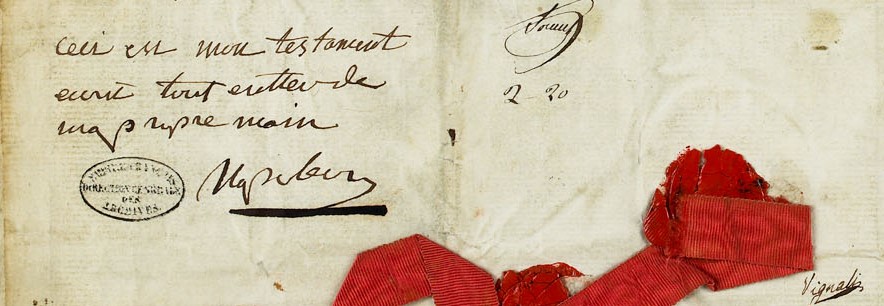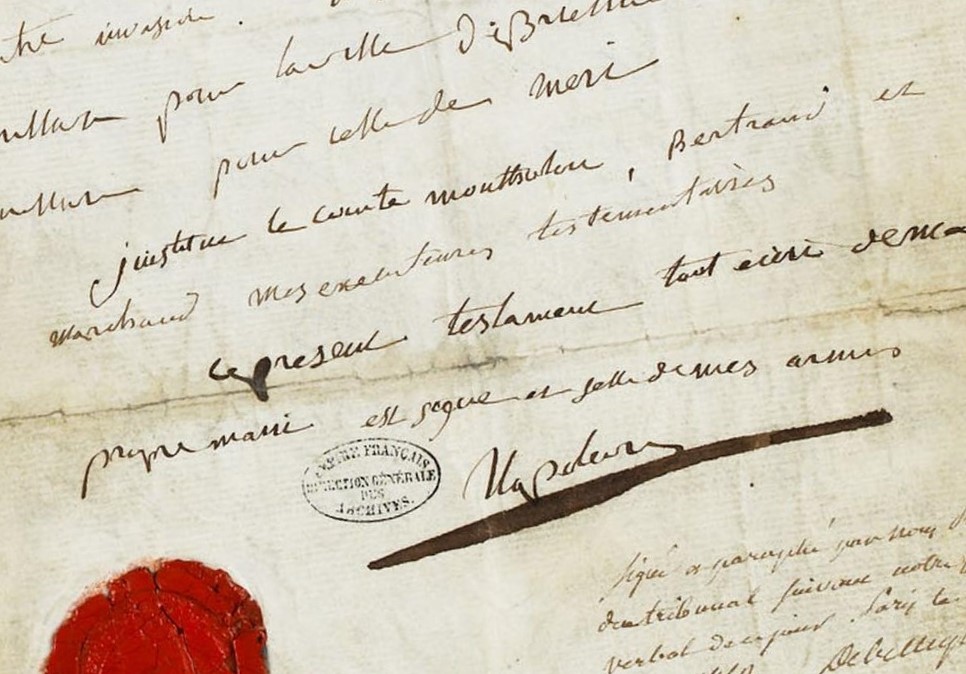The will of Napoleon
Data sheet of the collection
| Title | Holograph will of Napoleon |
|---|---|
| Date | April 1821 |
| Producer | Napoleon |
| Physical size | 13 documents |
| Content overview | Napoleon’s will is composed of a series of documents mainly preserved in the “Iron Cabinet” of the French Archives Nationales under the shelfmark: AE/I/13/21. It is completed by scattered documents, originals or copies, kept in the French Archives Nationales (Fond Murat), the Bibliothèque Thiers (Papiers Marchand, Ms 21) and in private collections. |
| Notes on the description | Since it is preserved in the “Iron Cabinet” of the French National Archives, the principal document is not accessible. It has been digitized and can be consulted on the Archim database of the French National Archives. |
Detailed description
Composition
Napoleon’s will is composed of a series of documents mainly preserved in the “Iron Cabinet” of the French Archives Nationales under the shelfmark AE/I/13/21. This main document is completed by scattered documents, originals or copies, preserved in particular in the French Archives Nationales (Fonds Murat), the Bibliothèque Thiers (Papiers Marchand, Ms 21) and in private collections.
The complete testimonial ensemble comprises the following documents:
1 - The last will and testament as such, paginated 1 to 14 in 1853 ( Archives nationales, AE/I/13/21a). It is entirely autograph, signed, sealed and dated Longwood the 15th of April, 1821. There are three “états” (a, A and B) in the hand of Marchand, Napoleon’s valet de chambre. Initialled by the Emperor, these give an inventory of some of the objects belonging to Napoleon on St. Helena. “États” B (silverware) and C (porcelain) are no longer kept with the main document in the French Archives Nationales. They are known through copies: Bibliothèque Thiers, Papiers Marchand, ms Masson 21; French Archives Nationales Fonds Murat, 31AP/28.
Inventories of the boxes (snuffboxes) numbered I, II and III, dictated the same day, were annexed to it. Absent from the set preserved in the National Archives, they are known by copies.
 The will of Napoleon, detail, AN, AE-I-23-21a ©Archives nationales
The will of Napoleon, detail, AN, AE-I-23-21a ©Archives nationales
2 - The first codicil, paginated 15 to 18 in 1853 (AN, AE/I/13/21b). It is entirely autograph, signed, sealed and dated at Longwood on the 16th of April, 1821. It represents the only will intended to be communicated to the British.
3 - The second codicil, paginated 1 and 2 (AN, AE/I/13/21c). It is entirely autograph, signed, sealed and dated at Longwood on the 16th of April, 1821. This document reserved for the French exiles is a complement of the first codicil and prescribes the opening of the will in Europe, and institutes as executors Montholon, Bertrand and Marchand.
4 - The third codicil, paginated 29 to 32 in 1853 (AN, AE/I/13/21d). It is entirely autograph, written on the 21st, 22nd or 23rd of April, sealed and dated the 24th of April. It disposes of the Emperor’s holdings on the crown diamonds and his income on the island of Elba.
5 – The fourth codicil, pages 33 to 36 in 1853 (AN, AE/I/13/21e). It is entirely autograph, written on the 21st, 22nd or 23rd, sealed and dated the 24th of April. It contains bequests to people Napoleon knew early in his career, provides for estate expenses, and the appointment of a treasurer. This document has lost the envelope in which it was sealed.
6 - The codicil (fifth) disposing of the funds remitted to the empress Marie-Louise (AN, AE/I/13/21f), paginated 37 to 40 in 1853. It is entirely autograph, written between 21st and 24th of April, signed and dated the 24th.
7 - The codicil (sixth) disposing of the funds of the civil list of Italy in the hands of Eugene de Beauharnais (AN, AE/I/13/21g), paginated 19 to 28 in 1853, nos. 20 and 27 have been omitted by mistake. It is entirely autograph, written between the 21st and 24th, signed and dated 24th of April.
8 - The seventh codicil, whose existence is attested by the witnesses, was written between the 23rd and the 25th. According to the witnesses, it was entirely autograph, signed and dated; the 5th and 6th codicils allude to certain provisions of this lost codicil. The text is known by copies, in particular that in the Fonds Murat at the French National Archives (31AP/28). It contained the ‘legs de conscience’ and was to remain secret. Its existence is attested until 1825; it would appear to have been destroyed thereafter. Only the envelope seems to have survived and was acquired by the National Archives, it is held under the shelfmark AE/I/13/21h.
9 - The eighth codicil, written by the Emperor on the 29th and backdated to the 27th. It is partly in his hand until the 4th paragraph. Articles 5 to 7, and the last three words of article 2, were written by Montholon who was unable to make Napoleon sign it. After drafting it, he showed it to the Grand Marshal Bertrand, but kept the document and took it to England. The document, never added to the main bundles, remained in private hands. In June 1938, it was sold in London at Sotheby’s, who offered it to the French National Archives, which was unable to acquire it. A photograph of the document was published by Jean Savant in 1951. It was sold again in the 1970s and has been in a private collection ever since.
10 - The ninth codicil. The text was dictated to Marchand on the evening of the 29th of April and written on the back of a playing card (king of hearts) which has been cut. Kept by the faithful valet, the text bears a bequest for the duke of Reichstadt. This document was kept in a private collection and exhibited for the first time in 2021 at the Invalides: Napoléon n’est plus (March-September 2021) and was reproduced in the catalogue: Paris, Gallimard, 2021, p. 40.
11 - Instructions for testamentary executors (AN, AE/I/13/21i), paginated 1 and 2. These instructions were dictated to Marchand between the 22nd and 25th of April, 1821 and written by the valet de chambre, signed by Napoleon and dated the 26th of April 26.
12 - Letter to Laffitte, the Emperor’s Banker (AN, AE/I/13/21k), written by Montholon, recopied by Marchand on the 29th, and signed by Napoleon on that day but backdated to the 25th of April.
13 - Letter to baron La Bouillerie, treasurer of the Emperor’s private domain (AN, AE/I/13/21j), written by Montholon, copied by Marchand on the 29th, and signed by Napoleon that day but backdated to the 25th of April.
Physical Description
Napoleon dictated a first version and copied that first version on the paper used at St. Helena. That used for the will is watermarked J. WHATMAN 1819 BALSTON & Co. The will, and the first two codicils, which were to be opened on St. Helena, are sealed with red ribbons. The other 6 codicils were sealed with green. On each of the bundles of paper, the executors present at Saint Helena (Bertrand, Montholon, Marchand) marked their initials and affixed their seals, the abbé Vignali was also invited to sign. The order of the documents, in particular the codicils, respects the classification established by the French National Archives, itself established according to the order set by the tribunal of the Seine at the time of its registration in 1853, which respects the order given by Montholon at the time when the will was proved at the “Doctors’ Commons” (society of lawyers practising civil (as opposed to common) law at which wills could be registered) in London1
History of the conservation
The various documents that make up Napoleon’s will were drawn up between the 11th and 29th of April, 1821. Signed and sealed by the executors, the documents were entrusted to Louis Marchand, valet de chambre, until the Emperor’s death on the 5th of May at 5.49 pm. That evening, Marchand handed over all the documents in his custody to the count of Montholon, the principal executor. After drawing up the minutes, the second codicil was opened. The first codicil was opened on the 12th of May by Hudson Lowe. The other codicils were opened by Montholon, in the presence of the executors, on the 25th of July aboard The Camel which was taking the exiles back to Europe. Upon his arrival in France in October, Montholon had copies made for the Tribunal de Seine and had the letter to Laffitte stamped for registration on the 2nd of November. On the advice of Cambacérès, on the 10th of December, 1821, he deposited the whole (apart from the 8th codicil) at the “Doctors’ Commons” (society of lawyers practising civil (as opposed to common) law at which wills could be registered) in London2. The 8th and 9th codicils were never to be officialised and were detached from the whole from this moment. Upon his arrival to the throne, Napoleon III asked Queen Victoria, through Count Alexandre Colonna-Walewski, Napoleon’s natural son and ambassador in London, for the documents that made up the Emperor’s last will and testament, which had been deposited at the Prerogative Court of Canterbury3 in London (Testament, codicils 1, 3 to 6 and the two letters). They were given to Walewski on the 16th of March 16, 1853 by Lord Clarendon, British minister of Foreign Affairs and brought back to Paris. Ten days later (on the 26th of March), the leaves were deposited at the Court of the Seine, numbered and initialled by its president, Debeylleme. The documents were stamped the same day, and annexed to the minute of an act deposited at the Emperor’s notary, Casimir Noël. Two missing pieces (the 2nd codicil and the Instructions) joined the first documents in June and July. The fate of the 7th codicil is unknown; it was attested until 1825 and then disappeared. After the final acquittal of the legacies between 1853 and 1859, by a letter dated the 28th of April, 1860, Napoleon III handed the will of Napoleon I to the Count de Laborde, Director General of the Archives of the Empire, who deposited it there. It has since been kept in the « Iron Cabinet ». Conditions of access and use The original documents are held in the “Iron Cabinet” of the National Archives and are not accessible to the public. The documents have been digitized and are available for consultation on the Archim, website of the French Archives Nationales.
 The will of Napoleon, detail of p. 5, AN, AE-I-23-21a ©Archives nationales
The will of Napoleon, detail of p. 5, AN, AE-I-23-21a ©Archives nationales
Online: July 2022
-
Also known as the Prerogative Court of Canterbury, London, traditionally the place where wills of those who died overseas were proved. ↩
-
Also known as the Prerogative Court of Canterbury, London, traditionally the place where wills of those who died overseas were proved. ↩
-
Also known as Doctors’ Commons” (society of lawyers practising civil (as opposed to common) law at which wills of those who died overseas could be registered). ↩